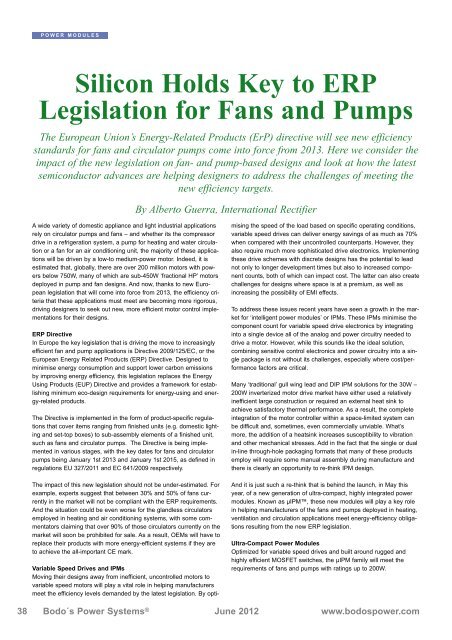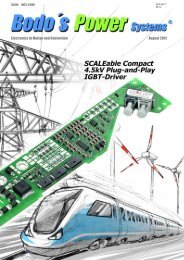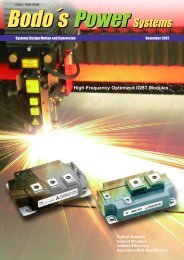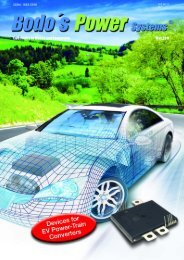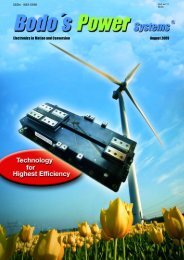Electronics in Motion and Conversion July 2012 - Bodo's Power
Electronics in Motion and Conversion July 2012 - Bodo's Power
Electronics in Motion and Conversion July 2012 - Bodo's Power
Create successful ePaper yourself
Turn your PDF publications into a flip-book with our unique Google optimized e-Paper software.
POWER MODULES<br />
Silicon Holds Key to ERP<br />
Legislation for Fans <strong>and</strong> Pumps<br />
The European Union’s Energy-Related Products (ErP) directive will see new efficiency<br />
st<strong>and</strong>ards for fans <strong>and</strong> circulator pumps come <strong>in</strong>to force from 2013. Here we consider the<br />
impact of the new legislation on fan- <strong>and</strong> pump-based designs <strong>and</strong> look at how the latest<br />
semiconductor advances are help<strong>in</strong>g designers to address the challenges of meet<strong>in</strong>g the<br />
new efficiency targets.<br />
A wide variety of domestic appliance <strong>and</strong> light <strong>in</strong>dustrial applications<br />
rely on circulator pumps <strong>and</strong> fans – <strong>and</strong> whether its the compressor<br />
drive <strong>in</strong> a refrigeration system, a pump for heat<strong>in</strong>g <strong>and</strong> water circulation<br />
or a fan for an air condition<strong>in</strong>g unit, the majority of these applications<br />
will be driven by a low-to medium-power motor. Indeed, it is<br />
estimated that, globally, there are over 200 million motors with powers<br />
below 750W, many of which are sub-450W ‘fractional HP’ motors<br />
deployed <strong>in</strong> pump <strong>and</strong> fan designs. And now, thanks to new European<br />
legislation that will come <strong>in</strong>to force from 2013, the efficiency criteria<br />
that these applications must meet are becom<strong>in</strong>g more rigorous,<br />
driv<strong>in</strong>g designers to seek out new, more efficient motor control implementations<br />
for their designs.<br />
ERP Directive<br />
In Europe the key legislation that is driv<strong>in</strong>g the move to <strong>in</strong>creas<strong>in</strong>gly<br />
efficient fan <strong>and</strong> pump applications is Directive 2009/125/EC, or the<br />
European Energy Related Products (ERP) Directive. Designed to<br />
m<strong>in</strong>imise energy consumption <strong>and</strong> support lower carbon emissions<br />
by improv<strong>in</strong>g energy efficiency, this legislation replaces the Energy<br />
Us<strong>in</strong>g Products (EUP) Directive <strong>and</strong> provides a framework for establish<strong>in</strong>g<br />
m<strong>in</strong>imum eco-design requirements for energy-us<strong>in</strong>g <strong>and</strong> energy-related<br />
products.<br />
The Directive is implemented <strong>in</strong> the form of product-specific regulations<br />
that cover items rang<strong>in</strong>g from f<strong>in</strong>ished units (e.g. domestic light<strong>in</strong>g<br />
<strong>and</strong> set-top boxes) to sub-assembly elements of a f<strong>in</strong>ished unit,<br />
such as fans <strong>and</strong> circulator pumps. The Directive is be<strong>in</strong>g implemented<br />
<strong>in</strong> various stages, with the key dates for fans <strong>and</strong> circulator<br />
pumps be<strong>in</strong>g January 1st 2013 <strong>and</strong> January 1st 2015, as def<strong>in</strong>ed <strong>in</strong><br />
regulations EU 327/2011 <strong>and</strong> EC 641/2009 respectively.<br />
The impact of this new legislation should not be under-estimated. For<br />
example, experts suggest that between 30% <strong>and</strong> 50% of fans currently<br />
<strong>in</strong> the market will not be compliant with the ERP requirements.<br />
And the situation could be even worse for the gl<strong>and</strong>less circulators<br />
employed <strong>in</strong> heat<strong>in</strong>g <strong>and</strong> air condition<strong>in</strong>g systems, with some commentators<br />
claim<strong>in</strong>g that over 90% of those circulators currently on the<br />
market will soon be prohibited for sale. As a result, OEMs will have to<br />
replace their products with more energy-efficient systems if they are<br />
to achieve the all-important CE mark.<br />
Variable Speed Drives <strong>and</strong> IPMs<br />
Mov<strong>in</strong>g their designs away from <strong>in</strong>efficient, uncontrolled motors to<br />
variable speed motors will play a vital role <strong>in</strong> help<strong>in</strong>g manufacturers<br />
meet the efficiency levels dem<strong>and</strong>ed by the latest legislation. By opti-<br />
By Alberto Guerra, International Rectifier<br />
mis<strong>in</strong>g the speed of the load based on specific operat<strong>in</strong>g conditions,<br />
variable speed drives can deliver energy sav<strong>in</strong>gs of as much as 70%<br />
when compared with their uncontrolled counterparts. However, they<br />
also require much more sophisticated drive electronics. Implement<strong>in</strong>g<br />
these drive schemes with discrete designs has the potential to lead<br />
not only to longer development times but also to <strong>in</strong>creased component<br />
counts, both of which can impact cost. The latter can also create<br />
challenges for designs where space is at a premium, as well as<br />
<strong>in</strong>creas<strong>in</strong>g the possibility of EMI effects.<br />
To address these issues recent years have seen a growth <strong>in</strong> the market<br />
for ‘<strong>in</strong>telligent power modules’ or IPMs. These IPMs m<strong>in</strong>imise the<br />
component count for variable speed drive electronics by <strong>in</strong>tegrat<strong>in</strong>g<br />
<strong>in</strong>to a s<strong>in</strong>gle device all of the analog <strong>and</strong> power circuitry needed to<br />
drive a motor. However, while this sounds like the ideal solution,<br />
comb<strong>in</strong><strong>in</strong>g sensitive control electronics <strong>and</strong> power circuitry <strong>in</strong>to a s<strong>in</strong>gle<br />
package is not without its challenges, especially where cost/performance<br />
factors are critical.<br />
Many ‘traditional’ gull w<strong>in</strong>g lead <strong>and</strong> DIP IPM solutions for the 30W –<br />
200W <strong>in</strong>verterized motor drive market have either used a relatively<br />
<strong>in</strong>efficient large construction or required an external heat s<strong>in</strong>k to<br />
achieve satisfactory thermal performance. As a result, the complete<br />
<strong>in</strong>tegration of the motor controller with<strong>in</strong> a space-limited system can<br />
be difficult <strong>and</strong>, sometimes, even commercially unviable. What’s<br />
more, the addition of a heats<strong>in</strong>k <strong>in</strong>creases susceptibility to vibration<br />
<strong>and</strong> other mechanical stresses. Add <strong>in</strong> the fact that the s<strong>in</strong>gle or dual<br />
<strong>in</strong>-l<strong>in</strong>e through-hole packag<strong>in</strong>g formats that many of these products<br />
employ will require some manual assembly dur<strong>in</strong>g manufacture <strong>and</strong><br />
there is clearly an opportunity to re-th<strong>in</strong>k IPM design.<br />
And it is just such a re-th<strong>in</strong>k that is beh<strong>in</strong>d the launch, <strong>in</strong> May this<br />
year, of a new generation of ultra-compact, highly <strong>in</strong>tegrated power<br />
modules. Known as μIPM, these new modules will play a key role<br />
<strong>in</strong> help<strong>in</strong>g manufacturers of the fans <strong>and</strong> pumps deployed <strong>in</strong> heat<strong>in</strong>g,<br />
ventilation <strong>and</strong> circulation applications meet energy-efficiency obligations<br />
result<strong>in</strong>g from the new ERP legislation.<br />
Ultra-Compact <strong>Power</strong> Modules<br />
Optimized for variable speed drives <strong>and</strong> built around rugged <strong>and</strong><br />
highly efficient MOSFET switches, the μIPM family will meet the<br />
requirements of fans <strong>and</strong> pumps with rat<strong>in</strong>gs up to 200W.<br />
38 Bodo´s <strong>Power</strong> Systems ® Bodo´s <strong>Power</strong> Systems <strong>July</strong> <strong>2012</strong> www.bodospower.com<br />
® Bodo´s <strong>Power</strong> Systems June <strong>2012</strong> www.bodospower.com<br />
® June <strong>2012</strong> www.bodospower.com


